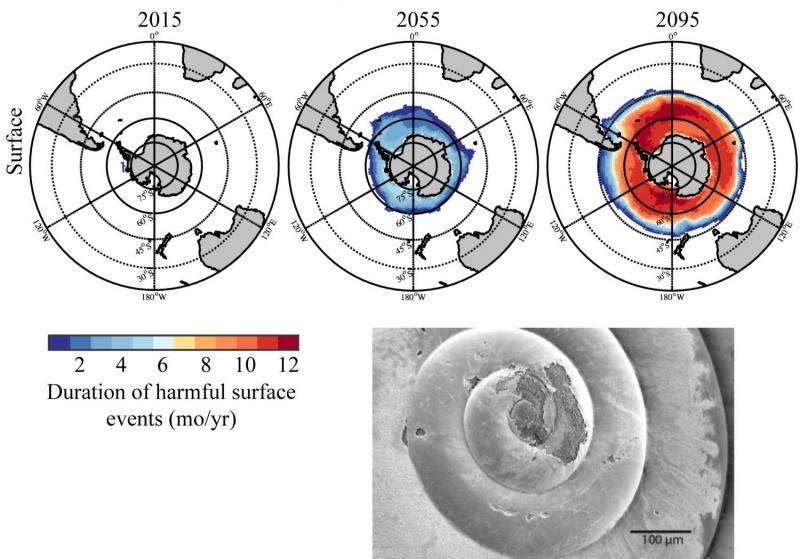Rapidly acidifying waters pose major threat for Southern Ocean ecosystem

As a result of increasing atmospheric carbon dioxide concentrations, the chemistry of the Southern Ocean is expected to change so fast over the next few decades that tiny creatures at the base of the food web may soon struggle to form their shells. New research by scientists from the University of Hawai'i, Mānoa (UHM) and the University of Alaska, Fairbanks (UAF) finds that for some organisms the onset of such critical conditions will be so abrupt, and the duration of events so long, that adaption may become impossible.
The study, published this week in the journal Nature Climate Change, uses a number of Earth System Models to explore how the uptake of anthropogenic carbon dioxide and the resulting ocean acidification will affect the Southern Ocean over the next century.
"The ocean acts as a gigantic sponge to absorb excess carbon dioxide from the atmosphere. This process consumes carbonate ions, which are required by key organisms to build and maintain their calcium carbonate shells. If the carbonate ion concentration drops below a threshold - we call it undersaturation - these organisms must spend more energy to fight dissolution in these adverse chemical conditions," explains Claudine Hauri, lead author of the study and a chemical oceanographer at both the International Artic Research Center (IARC) at UAF and the International Pacific Research Center (IPRC) at UHM.
One of the most threatened marine organisms is the pteropod, a tiny sea snail that serves as a staple for plankton, fish, whales, and seabirds.
Not only is the concentration of carbonate ions projected to fall to dangerously low levels due to ocean acidification, but these conditions will become the new norm across large areas of the Southern Ocean.
"Our analysis shows that in large parts of the Southern Ocean, the duration of such undersaturation events will increase abruptly from one month to more than six months, in less than 20 years upon their onset, and could reach nearly year-long durations by the end of the century," notes co-lead author Tobias Friedrich, climate scientist at IPRC.
"This is a clear warning sign. Given the projected rapid expansion and prolongation of these harmful conditions, it remains very uncertain whether pteropods and other vulnerable marine organisms will be able to adapt," adds Hauri.
Axel Timmermann, co-author of the study and oceanography professor at IPRC at UHM, concludes: "The only way to mitigate the risks of ocean acidification to marine life and our food supply is to curb our carbon dioxide emissions."
Watch animations and further explanation of the research:
More information: Abrupt onset and prolongation of aragonite undersaturation events in the Southern Ocean, DOI: 10.1038/nclimate2844
Journal information: Nature Climate Change
Provided by University of Hawaii at Manoa



















